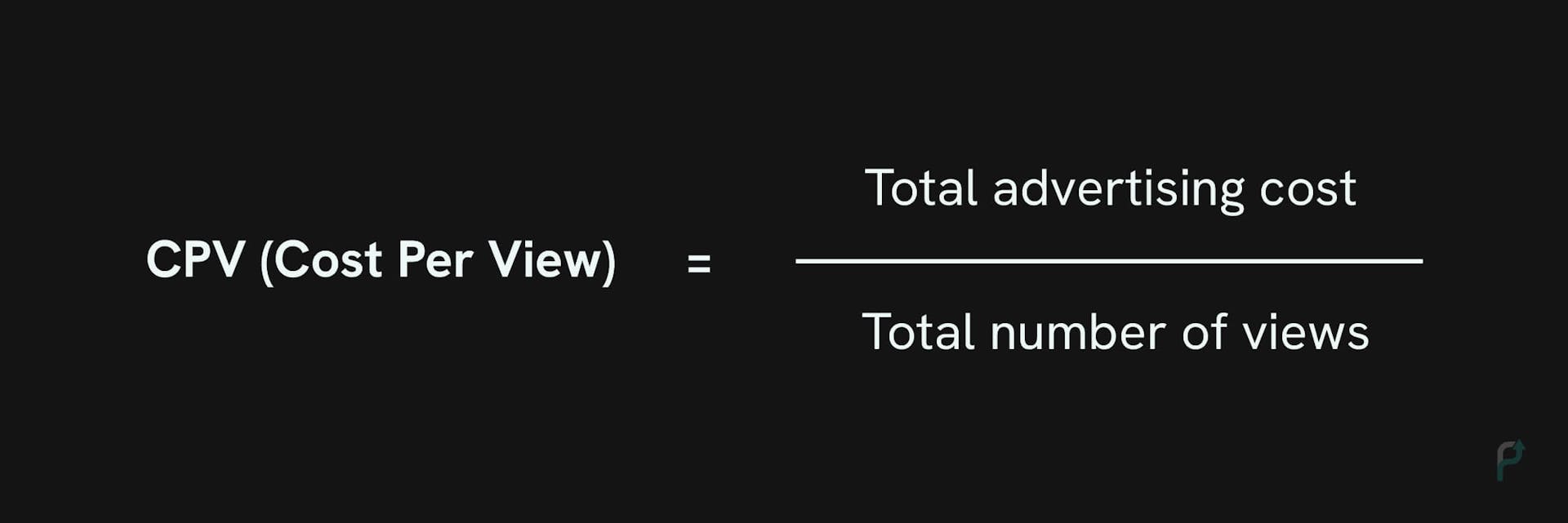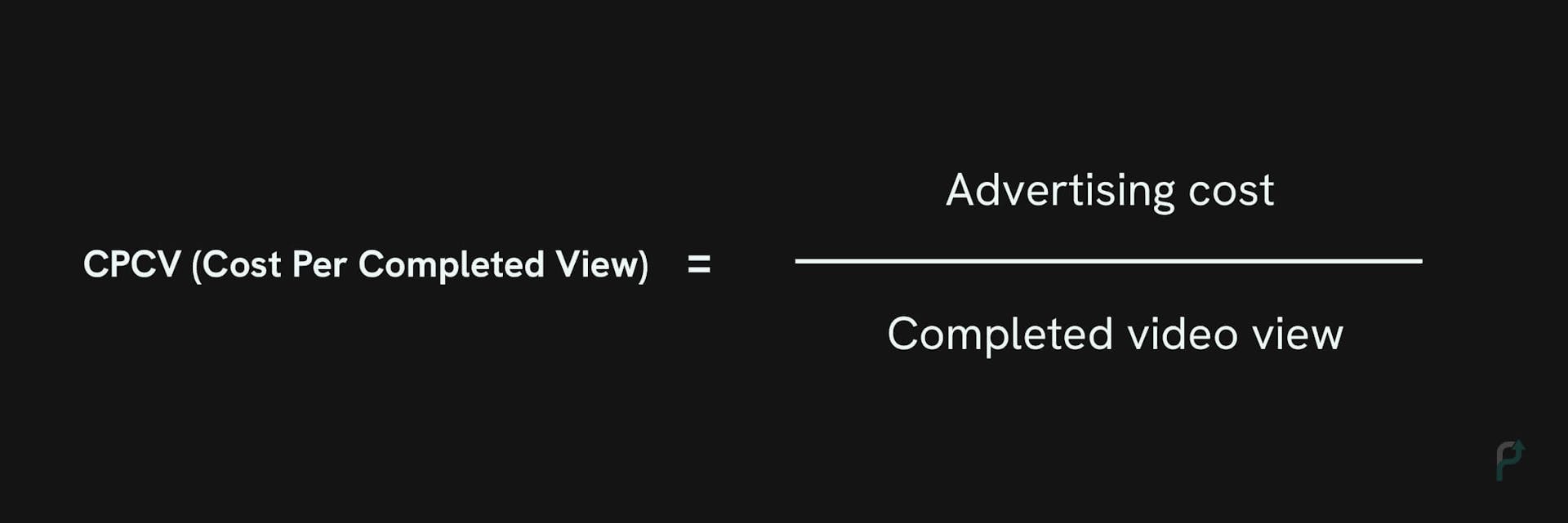- CPV (Cost Per View) and CPCV (Cost Per Completed View) will be thoroughly covered in this post. It will go over their definitions, calculations, and how they work. Additionally, it will discuss some excellent approaches to improve them.
- We'll also discuss the differences between CPV and CPCV before concluding.
The terms “Cost Per View" and "Cost Per Completed View" must be familiar to you if you're a video publisher or developer. Here is all the information you need to know about CPV and CPCV, from its definition, requirement to tips to optimize and boost it.
What is a Cost Per View
Cost Per View (CPV) refers to a pricing model where an advertiser pays each time a user views their video ad. This pricing model can serve as a helpful statistic for evaluating the ROI (Return On Investment) and the effectiveness of an advertising campaign.
If a viewer interacts with your video ad or views 30 seconds of it (or the duration if it's less than 30 seconds), whichever occurs first, it counts as a view.
Clicks on the cards, companion banners, and Call To Action (CTA) overlays are examples of video interactions. You specify CPV bids to inform Google of the highest price you're ready to pay for each view.
When you create your ad group, you can choose a maximum CPV bid for your video ads. According to other advertisers' bids, "maximum" means that the price you'll pay for a view will either be equal to or less than your own.
Further, you can only use the CPV bidding option if you choose to run TrueView video ads.
Customers may view your ad, read its text, and click your URL to go directly to your site when using standard online text or image ads. This type of interaction ignores interactive media like video ads.
You may determine how engaged your viewers are with your content, where they choose to watch your videos, and when they stop watching it by using CPV and video ad reporting.
What is an example of cost per view
An example of cost per view is the advertising model used in online video streaming platforms like YouTube, where advertisers pay a certain amount for every view their video ad receives.
YouTube cost per view video ad example:
 YouTube Cost Per View Ad Example
YouTube Cost Per View Ad ExamplePlease take note:
Although the CPV pricing model is one of the significant metrics of a successful video ad, it also applies to non-video ads.
How do you calculate cost per view
Take the total amount of ad spend, and divide it by the total number of views to get your CPV.
Here is the cost per view formula:
 Cost Per View (CPV) Formula
Cost Per View (CPV) FormulaWe can calculate CPV as follows using the CPV equation shown above:
For instance, if you spent $500 on a video ad campaign that got 50,000 views, your CPV would be $0.01 ($500/50,000).
How CPV Campaigns Works
When setting up your campaign (or ad group), you should specify the highest amount you are willing to pay per view as your CPV bid. Your bid is known as the maximum CPV bid, or "max.CPV". This bid is valid for every ad in the ad group.
Let us understand this with the help of an example:
You can set your maximum CPV bid to 0.30 USD if you believe someone will watch your video for 30 cents. Which implies:
- You will only be charged a maximum of 0.30 USD for an in-stream video ad when someone watches your video for 30 seconds (or the entire duration if it is less than 30 seconds) or interacts with an interactive feature, whichever occurs first. Examples of interactive features include cards, companion banners, call-to-action overlays (CTAs), and links to your website or mobile app.
- You will only be charged a maximum of 0.30 USD for an in-feed video ad when a viewer clicks on the thumbnail or title and starts viewing your video.
Additionally, you have the option to select a lower bid for your in-feed video ads compared to your in-stream video ads.
How to Select the max.CPV Bid Amount
Google provides reach assessments when starting a new campaign (or modifying ad groups). When you select targeting settings and max.CPV, you can base this amount on these reach estimations.
In addition, evaluate the value of a view and industry knowledge. Also, your maximum bid should consider the reach, budget, and spending.
Consider your reach, or the potential viewers for your ad, before anything else. Next, have a look at the daily maximum spending limit for your ads. Finally, decide how much to spend on each video ad view from that budget.
Increasing your maximum bid will increase views, but it will also consume more of your budget.
So think about which is more crucial to your business right now: cutting costs or gaining as many views as you can.
Types of CPV Ads
CPV ads give e-commerce merchandisers a platform to interact with their target market. Brands looking to increase their visibility should consider utilizing CPV marketing.
Google Ads, the largest platform for video advertising, offers the In-Stream and In-Display CPV ad types.
Two Types of CPV Ads:
- In-Stream Video ads
- In-Display ads
In-Stream Video Ads
The CPV ad type means inserting video ads before or within YouTube-hosted videos. YouTube's "in-stream" video ads are similar to commercial breaks on television that play before or after other videos.
The first five seconds of the advertisement are required viewing, after which viewers get the choice to skip it.
In-Display Ads
This CPV ad type suggests that YouTube will display video ads in addition to regular videos. In-display ads are videos offered as clickable options next to other videos on YouTube or additional Google search results.
With the 30-second restriction in place, marketers have a fair amount of freedom to experiment with various ad formats. They can test short, long, humorous, serious, in-stream, or in-display videos, but they will only pay for those that viewers find interesting.
This provides marketers with plenty of opportunities to test various app marketing strategies and identify the most economical choices.
What is Cost Per View Bidding
The same principles that apply to other Pay Per Click (PPC) marketing strategies apply to CPV bids.
The highest bid, if any, determines which ad is displayed for the searcher if more than one advertiser has placed a bid on that specific keyword metric combination.
For specific terms that users submit into the advertising system, a marketer sets "bids" within the system. These bids are further limited based on criteria like the searcher's location.
Markets with many people and popular keywords almost generally require higher bids because there is tremendous competition among marketers for such keywords. As a result, the cost of CPV advertising might vary greatly depending on a wide range of variables on the searcher's end. The typical cost per view ranges from roughly 3 cents to 30 cents, but that is only an estimate.
What are the Advantages of Cost Per View
A CPV model has several benefits for your online advertising:
- CPV is a more specific approach to estimating success because you only pay when someone views your ad (instead of when it is just served).
- With CPV campaigns, you can target particular demographics in ways that aren't possible with CPM (for example, you can target those who have already watched similar videos).
- You don't have to agree to pay a specific amount up ahead. Thus, it's more flexible than CPM because you can choose your budget.
What are the Benefits of CPV Advertising
CPV advertising is a superb method to increase traffic to your website because it is a very economical form of advertising.
Some of the main CPV advertising benefits include:
- Cost-effective ad campaigns
- Specific demographics Targeting
- Tailored to your budget
-
Cost-effective ad campaigns: You only pay when someone views your ad, so you know your budget is going on those ads that people watch. As a result, CPV advertising is far more effective than other types of advertising, such as CPM or PPC, which can be reasonably expensive and ineffective.
-
Specific Demographics Targeting: Targeting particular demographics is possible with CPV advertising. As a result, you can target your ads directly at users who are most likely to be interested in what you offer. This ensures that the right individuals see your ads and that you aren't wasting money on ones nobody will ever view.
-
Tailored to your Budget: The ability to tailor CPV advertising to match your budget is another fantastic feature. To avoid going overboard, you can set a daily or monthly budget for your CPV campaigns and modify your bids accordingly. Due to its adaptability, CPV advertising is perfect for companies of all sizes, from sole proprietorships to multinational partnerships.
What sets CPV apart from other forms of online advertising
The fundamental difference between CPV and other bid-based advertising models like Cost Per Mille (CPM) is that CPV demands conscious attention from the viewer who is watching the video advertisement.
The CPV fee is not applied on Google Ads platform unless the user engages with the ad, such as by clicking an embedded link or watching it for at least 30 seconds. This makes CPV-based video advertising more reasonable for marketers because they do not have to pay for viewers who quickly click away from an advertisement out of boredom.
Although Facebook and other platforms have started experimenting with similar ideas, the CPV strategy is commonly linked with Google and its TrueView methodology for circulating YouTube-based ads.
How to Improve and Boost your CPV
Understanding the optimal range is necessary before you can maximize your CPV.
A decent CPV usually costs between 3 cents to 30 cents. The specific quantity, however, totally relies on the type of campaign, the target market, and the business. A poor CPV, on the other hand, would exceed your advertising budget.
If you're running ads to promote your brand, think about how much you can afford to pay to have one person see your video. Measure your CPV along with other metrics if your priority is conversion rates.
Here are a few of the best practices to improve and boost your CPV:
- Calculate CPV in addition to other measures
- Make engaging, high-quality videos
- Improve your video ad campaigns
Calculate CPV in addition to other measures
CPV alone won't present you with the whole picture; you also need to take other metrics like CPM, CPI, and CPCV into account. Also, track your actual installs or conversions as well as your maximum bids with the help of a mobile app user acquisition platform.
Make engaging, high-quality videos
It's essential to create your videos genuinely interesting and relevant if you want people to view them. Invest in creating high-quality videos, and keep testing various versions with your audience to discover the best fit.
Improve your video ad campaigns
To make your campaigns more effective, use best practices for video advertising. Improve your landing pages, keywords, and ad targeting to engage with and reach your audience more effectively. As a way to improve campaign success over time, you should also test each campaign and apply fitting tags.
What is CPCV
CPCV stands for Cost Per Completed View. This model is an online advertising price structure that only charges the advertiser after the user has finished watching the entire video. After a campaign reaches a specific KPI threshold (such as a minimum spend), advertisers pay a flat amount for each completed video watch.
This is a variant of the more typical Cost Per View (CPV) pricing model, in which the advertiser is charged for every view, whether the viewer sees the entire advertisement or not.
With the CPCV pricing model, advertisers can make the highest imprint on their target audiences and deliver the highest Return On Investment (ROI) for their campaign.
CPCV makes it easier for advertisers to target high-quality users at a considerably lower risk.
How do you calculate CPCV
You can compute CPCV as follows:
CPCV formula = Advertising cost / Completed video view
 Cost Per Completed View (CPCV) Formula
Cost Per Completed View (CPCV) FormulaYou are dividing the whole cost of your video ad campaign by the number of users who watched it all the way through.
For example, suppose you were an advertiser who invested $3,000 in a video campaign that attracted 300 finished views.
The CPCV would be resolved by:
CPCV = $3000/300
CPCV = $10
The lower the CPCV, the better, similar to most video pricing practices.
How CPCV Campaigns Work
Let us understand this with the help of an example:
- A firm, Company A, develops a cost-per-completed view campaign.
- Next, Publisher X's platform hosts the 30-second video.
- After five seconds, user Kathie clicks away from the ad because she is uninterested in the app it is promoting.
- Then, user Jacky sees the advertisement and watches it from start to finish. The marketed app has captured her attention a lot.
- In this instance, Publisher X would not get anything from Company A for User Kathie's five-second view. But Publisher X would receive payment from Company A for User Jacky's view.
 How CPCV Campaigns Work
How CPCV Campaigns WorkWhat is CPCV Advertising
In contrast to other campaign pricing models like the CPI (Cost Per Install) model, where users must take the call to action at the end for an advertiser to pay, CPCV advertising involves the advertiser paying for each view.
CPCV advertising is a type of incentivized advertising. The user and the publishers both benefit from the CPCV ad model. A balanced value exchange between the advertiser, publisher, and user is provided via ad units such the offerwall, rewarded video, and playables.
Users are rewarded for their time and attention (in the form of premium in-app content), publishers get compensated for their incredible content range, and advertisers only have to pay for quantifiable, opt-in, completed views.
What makes CPCV Beneficial
The Cost Per Mille (CPM) and Cost Per View (CPV) pricing models are the two most widely used pricing models for video advertising.
But metric transparency is one of the central concerns that advertisers are facing.
CPMs frequently don't accurately reflect the performance of a campaign, and video advertising often has little visibility.
A CPCV pricing strategy reduces the possibility of wasted ad spend. Further, it guarantees that you're paying for high-quality users who see your ad in its entirety.
Due to somewhat poor completion rates of mobile video ads, not all ad networks and publishers offer CPCV pricing. Transparency and trust between advertisers and publishers are benefits of CPCV pricing.
Unskippable video advertising offers an alternative but may hinder the user experience.
Publishers and networks can accurately predict video ad campaigns' success when combined with rewarded advertising ads. Further, rewarded video ads provide in-app benefits to app users in exchange for watching the entire video. If you're wondering how to increase app engagement, this approach holds significant potential.
The term "video completion" has different meanings on different platforms. For instance, Facebook and Instagram count 15 seconds for videos and 3 seconds for stories, whereas YouTube counts 30 seconds as a complete view.
Nothing is assured, just like with any other ad price strategy. Compared to other metrics like click-through rates, a completed video view is not always more beneficial.
As a result, marketers must constantly test various pricing strategies to see which ones are effective for their target markets.
How to Improve your CPCV
The following suggestions will help you improve your cost per completed view:
- Ad rotation
- Start with CPI, then use CPCV to improve
- Boost your hook
- Utilize square and vertical mobile aspect ratios
- Increase your target audiences
-
Ad rotation: To lower ad fatigue and get more information on the best-performing video types to use, rotate at least two to three ad creatives in your auction.
-
Start with CPI, then use CPCV to improve: Starting your campaign by optimizing for Cost Per Install (CPI) can help you identify a suitable target market. Utilize CPCV to expand your CPI campaign once you've narrowed your target to a specific group to continue making sales afterward.
-
Boost your hook: Every video ad must capture the user's attention within the first five seconds. Try out various openings in your testing.
-
Utilize square and vertical mobile aspect ratios: To improve performance for various device sizes, diversify your video creatives. This could include the following: vertically 9:16, landscape 16:9, and square 1:1.
-
Increase your target audiences: The level of competition will increase as your ad becomes more focused. Expanding your target audience will help you find new audiences that might be more profitable if your CPCV is too expensive.
What is the Difference Between CPV and CPCV
Since the days when CPM (cost per thousand impressions) was the only thing that mattered, a lot has changed.
For ad formats like static and video, the metrics we use to buy advertising have changed to keep up with new technology, consumer behaviors, and industry trends.
Marketers can now ensure the outputs they require by using performance-based models like CPV and CPCV marketing.
Which one, CPV or CPCV, is more efficient for calculating the ROI of a video campaign?
Although the IAB and other organizations work to standardize terminologies, many critical concepts like "views" remain subjective. Using video ad metrics, such as cost-per-view models, has remained challenging due to the lack of consensus on definitions and measurement standards.
Advertisers are looking for innovative methods to pay to get the most out of their video ad campaigns.
Cost Per Completed View (CPCV) advertising can help with that.
The CPCV pricing structure offers advertisers the best opportunity to make the biggest impression on their viewers and deliver the highest ROI for their campaign.
The advertiser can utilize CPCV advertising to only pay for a video ad after the user has completely watched the video in its entirety. Instead of the entire video, some publishers define a view as "completed" when the user has finished watching a specific amount of time.
Now the question surfaces-
Do we need to take CPCV into account for every video campaign?
Several factors, like your campaign's goal, media placements, and the actual creatives, come into play.
Consider CPV vs. CPCV with traditional digital marketing. If you invest in the display, would you stop running search ads? No, not at all. Due to the complexity of today's marketing environment, you need a comprehensive solution that satisfies your goals and coordinates all of your campaigns.
In Conclusion
The bottom line is that CPCV is a performance-based measurement system created to increase the frequency of visits from your dedicated customers. This also drives a continuous stream of new visitors. However, CPV pricing model excels at achieving those objectives since there are constantly new products, seasonal discounts, and other occasions to advertise. Further there are numerous media placements with a large potential viewer base.
CPCV model tackles many of the market-wide challenges with accountability, transparency, and performance, so the industry is generally starting to favor it. Although the transition has not been easy, advertisers and publishers will benefit in the end.
Further, whatever pricing model you pick, it's always a good idea to ask what you're getting, including how the ad is delivered, what a "view" or "completion" technically means, and how viewability is validated.
By doing this, you can ensure that everyone is on the same page and set your ad campaign up for success.
The only ad platform built for developers by developers.
Contact us now for a product that fits your needs! It’s quick, simple and easy.



